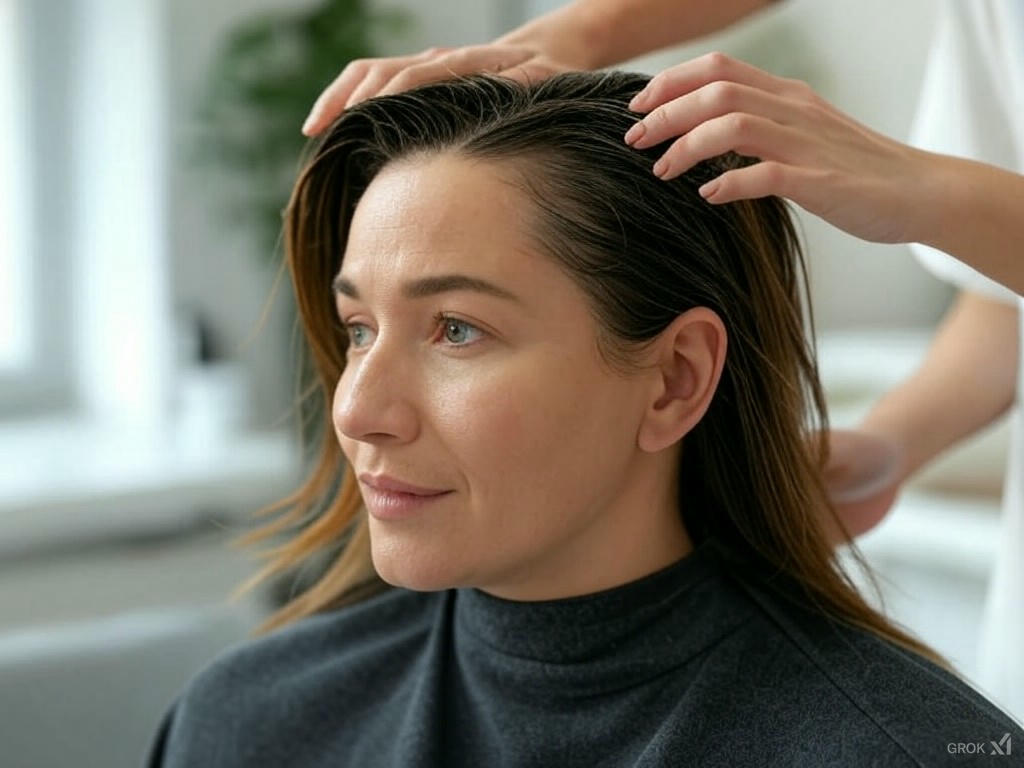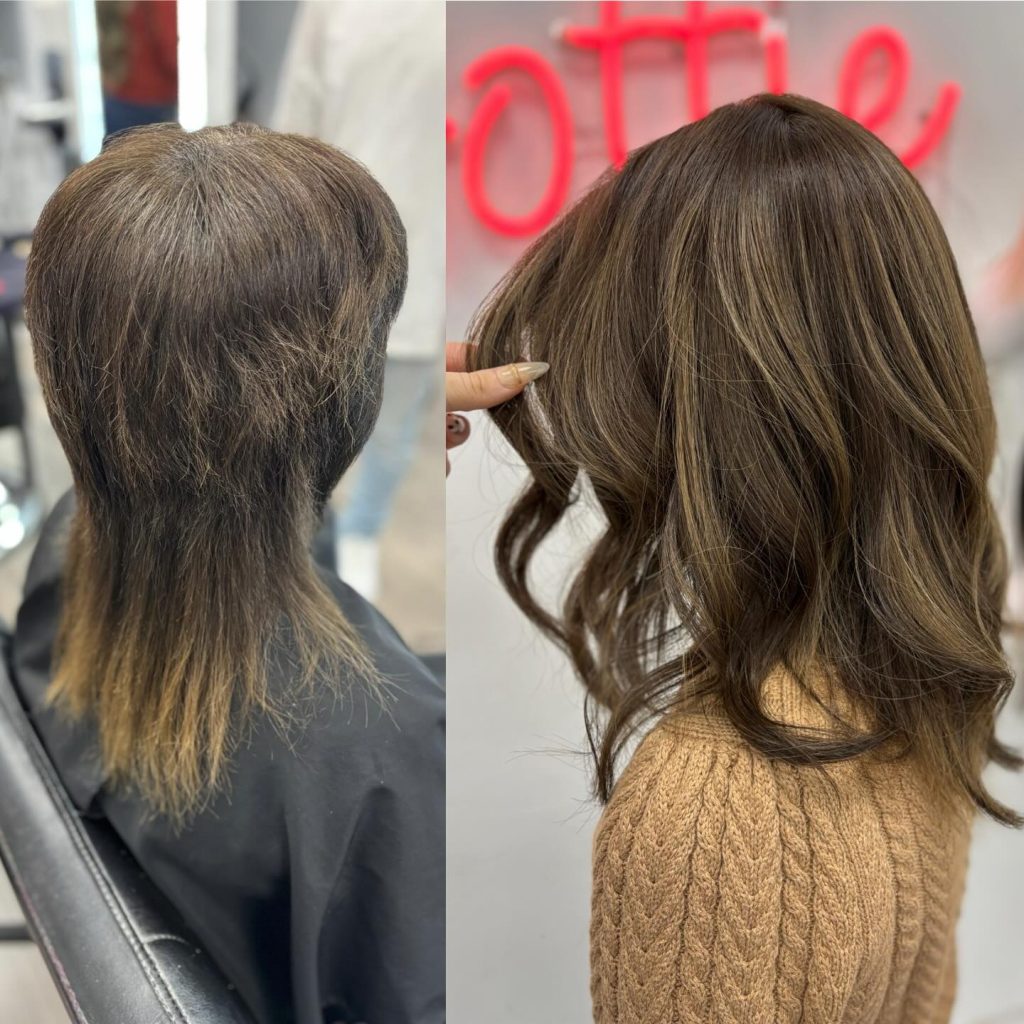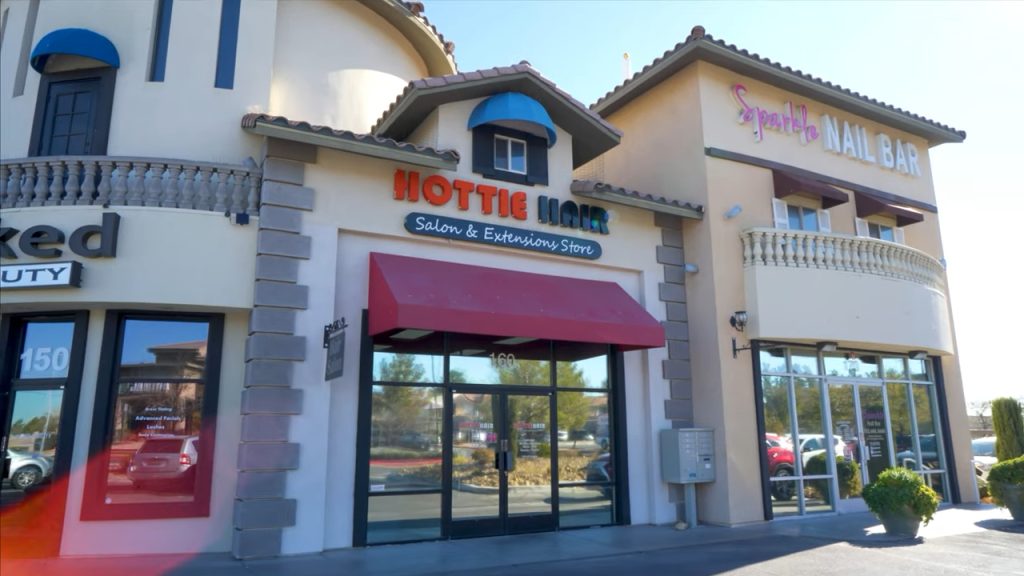1500+ ★★★★★ REVIEWS
Understanding Chemical Damage Hair Loss and Effective Solutions

Chemical damage hair loss occurs when the hair is subjected to harsh chemical treatments such as coloring, perming, relaxing, or bleaching, which can weaken the hair shaft and lead to breakage, thinning, or even hair loss. Over time, repeated chemical processes can strip the hair of its natural oils, causing it to become brittle and fragile. Understanding the causes and effects of chemical damage is essential for addressing this type of hair loss. Fortunately, there are effective solutions to restore hair health, including gentle hair care routines, deep conditioning treatments, and non-surgical options like hair extensions or wigs, which can help you regain fullness and confidence.
Table of Contents
How Does Chemical Damage Cause Hair Loss?
Chemical damage causes hair loss by weakening the hair shaft and disrupting its natural structure. When hair is exposed to chemicals from treatments like coloring, bleaching, perming, or relaxing, the protective cuticle layer can become damaged or stripped away. This leaves the hair more vulnerable to environmental factors and mechanical stress. Over time, repeated exposure to these harsh chemicals can make the hair brittle, dry, and prone to breakage. The hair follicles may also become damaged, leading to slower regrowth or thinning in the affected areas. This damage can result in noticeable hair loss, which may require professional treatments to repair and restore hair health. Common signs of chemical damage include:
- Excessive breakage and split ends
- Increased hair shedding
- Dry, brittle, or frizzy hair
- Thinning or bald patches in severe cases
When the scalp is exposed to harsh chemicals frequently, it can lead to inflammation and weaken hair follicles, making hair loss more likely.
Medical Solutions for Chemical Damage Hair Loss
Medical solutions for chemical damage hair loss focus on restoring hair health and promoting regrowth through professional treatments and interventions. After chemical damage has weakened the hair, there are several medical options available to repair the scalp and hair follicles. These solutions may include prescription medications like topical minoxidil or oral finasteride, which stimulate hair growth, as well as advanced therapies such as platelet-rich plasma (PRP) treatments, which harness the body’s healing properties to rejuvenate the scalp. In some cases, hair restoration procedures like transplants or scalp micropigmentation (SMP) may be recommended. A combination of these medical treatments can help improve hair quality and regrow thinning areas caused by chemical damage.
- Scalp Treatments and Serums: Formulated with ingredients like biotin, keratin, and essential oils, these treatments nourish the scalp and strengthen hair.
- Minoxidil (Rogaine): This FDA-approved topical treatment stimulates hair regrowth by improving blood circulation to the scalp.
- Platelet-Rich Plasma (PRP) Therapy: A dermatologist may recommend PRP injections to encourage hair regrowth.
- Hair Transplantation: In severe cases, a hair transplant may be necessary to restore hair permanently.
For further medical guidance, refer to resources from the American Academy of Dermatology and the National Institutes of Health.
Non-Medical Solutions: Enhancing Your Hair’s Appearance
Non-medical solutions offer an effective way to enhance the appearance of your hair without the need for surgery or medications. Options like mesh integration systems, hair toppers, wigs, and extensions can provide instant volume, coverage, and length, helping you achieve a fuller, more confident look. Mesh integration involves attaching a breathable mesh base to the scalp, seamlessly blending with your natural hair. Toppers and wigs offer full coverage for thinning or balding areas, while extensions add volume and length to create a luxurious, natural appearance. These non-invasive solutions are customizable to match your hair type, color, and style, providing an immediate transformation without the long-term commitment.

1. Mesh Integration Systems
Mesh integration is a revolutionary solution for individuals experiencing moderate to severe hair thinning due to chemical damage. This technique involves attaching a breathable mesh base to the scalp, onto which high-quality hair extensions are secured. The result is a natural-looking, full head of hair without the need for surgery or adhesives.
2. Clip-On Toppers
Clip-on toppers are a great option for those looking to add volume and coverage quickly. These hairpieces attach securely to thinning areas, blending seamlessly with natural hair. Available in various colors and styles, toppers offer flexibility and convenience.
3. Wigs and Hairpieces
For those experiencing significant hair loss from chemical damage, wigs provide an excellent temporary or long-term solution. High-quality human hair and synthetic wigs offer a realistic appearance, allowing for styling versatility and confidence.

Why Choose Hottie Hair Salon & Extensions Store?
At Hottie Hair Salon & Extensions Store, we are dedicated to providing you with the highest quality hair solutions tailored to your unique needs. Whether you’re looking for premium extensions, wigs, or non-surgical options like mesh integration, our expert team ensures a seamless, natural-looking result every time. We pride ourselves on offering personalized consultations to help you find the perfect match, whether for everyday wear or special occasions. With a wide selection of 100% human hair products and a commitment to customer satisfaction, Hottie Hair is your go-to destination for enhancing your hair with confidence and style.
At Hottie Hair Salon & Extensions Store, we specialize in non-medical hair restoration solutions tailored to your needs. Our services include:
- Customized Hair Extensions to enhance volume and length.
- High-Quality Wigs and Toppers for natural-looking coverage.
- Professional Mesh Integration Services for a long-lasting, undetectable solution to thinning hair.
Final Thoughts: Find the Right Solution for You
Finding the right solution for your hair needs is a personal journey that involves understanding your unique hair type, goals, and lifestyle. Whether you’re experiencing hair loss, looking to add volume, or simply want a new look, there are a variety of options available, from medical treatments to non-invasive solutions like wigs, extensions, and mesh integration. It’s important to choose the option that best fits your needs, budget, and comfort level. At Hottie Hair, we are here to guide you through the process, offering expert advice and high-quality products to ensure you find the perfect solution for a confident and beautiful you.
Book a consultation today at Hottie Hair Salon & Extensions Store and discover the best hair restoration solutions for you!
FAQ: Chemical Damage Hair Loss
1. What causes chemical damage hair loss?
Chemical damage hair loss is caused by repeated exposure to harsh chemicals, such as those found in hair dyes, bleach, perms, and relaxers. These treatments can weaken the hair shaft, strip the hair of its natural oils, and make it more prone to breakage. Over time, this damage can cause hair to become brittle and fragile, leading to thinning or noticeable hair loss.
2. How can I prevent chemical damage to my hair?
To prevent chemical damage, it’s important to minimize the use of harsh hair treatments or choose gentler, ammonia-free alternatives. Regular deep conditioning treatments, using protective hair masks, and reducing the frequency of chemical processes can help keep your hair healthy. Additionally, protecting your hair from excessive heat styling and sun exposure is key to maintaining its integrity.
3. Can chemical damage be repaired naturally?
While chemical damage cannot be fully reversed, you can restore your hair’s health through deep conditioning treatments, oils, and hair masks that nourish and strengthen weakened strands. Regular scalp massages can promote circulation, helping hair regrowth. However, for more severe damage, non-medical options like hair extensions or mesh integration can provide immediate volume and coverage.
4. What are the best treatments for chemical damage hair loss?
For chemical damage hair loss, medical treatments such as topical minoxidil or platelet-rich plasma (PRP) therapy may help stimulate hair regrowth. These treatments can strengthen hair follicles and promote healthier hair growth. For a more immediate solution, non-medical options like wigs, hair toppers, and mesh integration systems offer full coverage and natural-looking volume.
5. Can I use hair extensions to cover chemical damage?
Yes, hair extensions are an excellent option to cover chemical damage while allowing your natural hair to heal. High-quality extensions made from human hair can add volume, length, and thickness, providing a seamless, natural look. At Hottie Hair, we offer a variety of extensions tailored to your needs, so you can regain your confidence without damaging your natural hair further.
6. How does mesh integration help with chemical damage hair loss?
Mesh integration is a non-surgical solution where a breathable mesh base is secured to the scalp, blending seamlessly with your natural hair. High-quality human hair is then integrated into the mesh, creating the appearance of fuller, thicker hair. It’s a great option for those looking to cover areas affected by chemical damage without the need for invasive procedures.
7. How long does it take to see results from hair recovery treatments?
The time it takes to see results from hair recovery treatments varies depending on the severity of the chemical damage and the treatment used. Medical treatments like minoxidil may take several months to show visible improvement, while non-medical solutions like hair toppers or extensions provide immediate results. Consistency with treatments and patience are key to regaining hair health.
8. Are there any side effects of using hair extensions for chemical damage?
Generally, hair extensions do not cause further damage if applied properly, but improper installation or overuse can lead to stress on the natural hair, potentially causing traction alopecia. It’s important to work with professionals to ensure your extensions are applied correctly and to maintain a gentle hair care routine to minimize any risk of damage.
9. What are the benefits of using hair toppers for chemical damage?
Hair toppers are a fantastic non-invasive solution for covering thinning or damaged hair. They come in various sizes, shapes, and colors, making them easy to match with your natural hair for a seamless, natural look. Toppers add instant volume and fullness, providing a temporary way to manage hair loss or damage while your natural hair heals and regrows.
10. Can chemical damage hair loss be permanent?
Chemical damage hair loss can be permanent if the hair follicles are severely damaged and unable to regenerate. However, with proper care, treatment, and time, many individuals can restore healthy hair growth. For those dealing with permanent damage or significant thinning, non-medical solutions like wigs, extensions, or mesh integration can offer a long-term way to enhance appearance and regain confidence.
You must be logged in to post a comment.